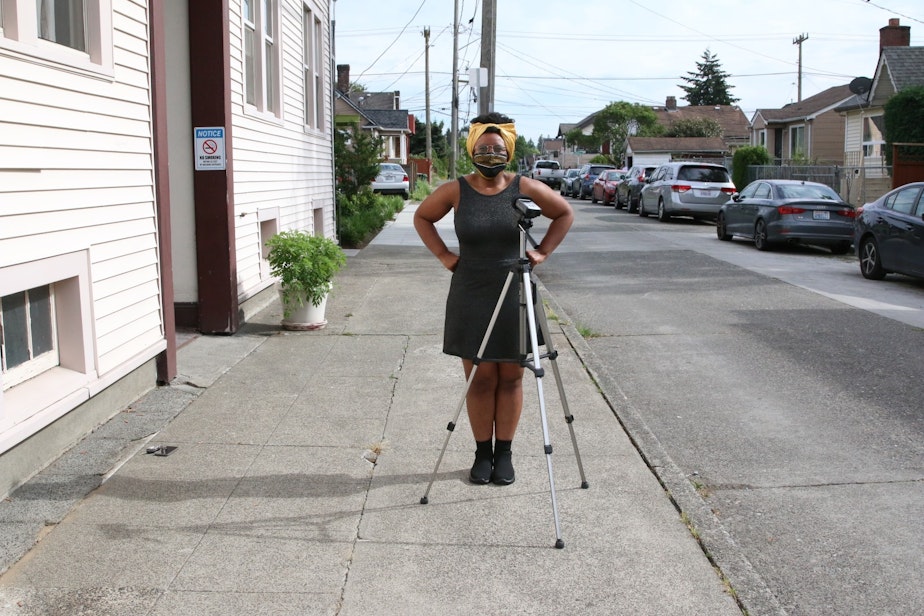‘It’s cry time.’ This Seattle woman’s response to the pandemic

Everyone has a story. That was the mantra as KUOW reporters set out to chronicle the lives of people who live and work on a small block in Seattle’s Beacon Hill neighborhood in the time of Covid-19. Read the stories at covidontheblock.com.
Early in the pandemic, Ariana Bray would sit at the kitchen table in her apartment and look out at the world below.
“I live alone, and so I haven’t seen anybody in a few months and it’s really lonely,” Bray said. “Sometimes I wake up in the morning and forget that it’s still pandemic time, and I’m like, ‘Oh, I’m going to see my friends. What am I going to do today?’ And then I realize my day is confined to these four walls.”
Bray was a 27-year-old engineer for Google and now, because of Covid, she was working remotely in this small apartment without air conditioning. She makes good money, but she lives modestly because she’s helping pay her mother’s bills.
Early this spring, she tried to lose herself in projects, “hoping that just those little bits of contact would be enough to like make me feel like I still have a purpose,” she said.
She tutored a kid from the Congo. She did work on a website, to help people navigate the pandemic.
“I just ended up getting really, really burned out,” she said. “I was pouring so much into all of these different things. And at the end of the day, when you hang up the last Google Hangout, you’re still by yourself. And you’re like, well, that didn’t help anything. I feel like I just gave a lot and didn’t necessarily get a lot in return.”
The low point came unexpectedly one day.
She tried video calling friends and family, but nobody was available to talk.
“I was just like, ‘Wow, I’m really just alone. Nobody here. Like, what if something happened, nobody would know.’” she recalled. “And I just got so lonely, and the stress from all these projects was just heaped on and heaped on and so I just like…”
Something had to give.
Bray decided to cry. On purpose.
She set up everything, climbed into bed, and said: "Okay, it's cry time.”
She cried for 4 hours.
“At the end of it, I felt the same, in a way, but that was comforting because it was like it didn't change because I had all these emotions, I'm still the same person, I'm not any more weak than I was before,” she said.
And then a shift. Three months into the pandemic, Bray left her apartment to protest police brutality on Capitol Hill. As a Black woman, she said the risks of COVID 19 exposure were outweighed by the risks of staying silent.
She marched every day for weeks. She breathed tear gas. She was with people, surrounded by them. She described it as an outburst of emotion.
“Yelling something, even if it's not what I want to yell, which would probably just be mostly profanity ... is helpful,” she said. “To feel things and do something with my body that felt like it was doing something that mattered, helped me when I came home, here by myself to hang out for two weeks.”
Come summer, Bray found two things had changed.
Where once she’d felt isolated, now she was overwhelmed with notes of concern from her white friends and colleagues offering emotional support.
“Oh my God, texts and Instagram messages and like, at work, oh my God at work, everyone just Slacking me. You know, like, ‘I just wanted to let you know that like, I am here for you in these like, just wild times and that, like, you're so valuable,’ and I'm like, Girl, I know. I know.”
She appreciated the notes, but they became exhausting to respond to, so she told them to just send her money by Venmo, which she used for takeout food.
The second change: Bray started thinking differently about her empty apartment.
Once, it had felt oppressive. Now, it began to feel like a refuge.
“Working on liking myself by myself is something I’ve been working on,” Bray said. “Before when I was thinking about the empty room in the sense of isolation, I was like, wow, this is super negative and there's nothing here. There's nothing of value.”
Earlier that summer, Bray had ordered colored lights that she controls through her Google smart speaker. She can change the color so the lighting in the apartment matches her mood. Now, she said she thinks of her tiny apartment as a metaphor for herself.
She no longer feels so confined by her isolation.
“Before all this happened, I would sort of wait for people to notice if I were sad and then kind of confront my emotions, or I’d wait until somebody had the space for me to vent to them,” Bray said. “And I was like, wait a second, I don't need to. I could vent on my own. I have a mirror; I can talk in the mirror and have that same cathartic experience. And then I don't have to rely on somebody else to help me through that.”
In the mirror, she’s found an honest conversation partner.
Because, she said, friends will validate your emotions, but it’s harder to lie to yourself.


